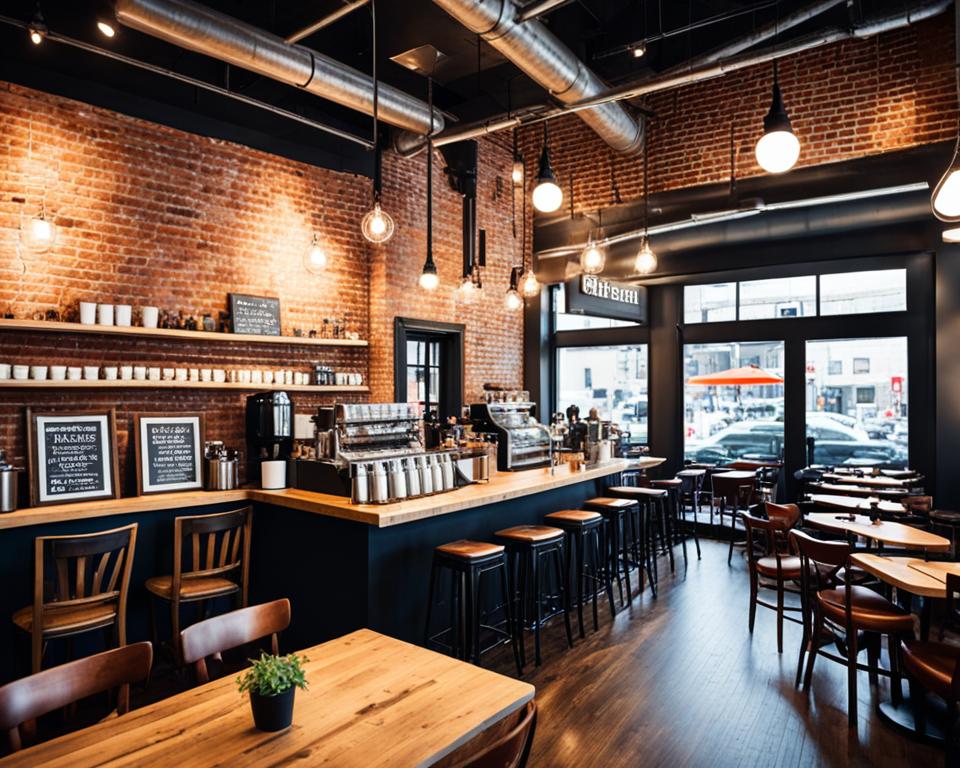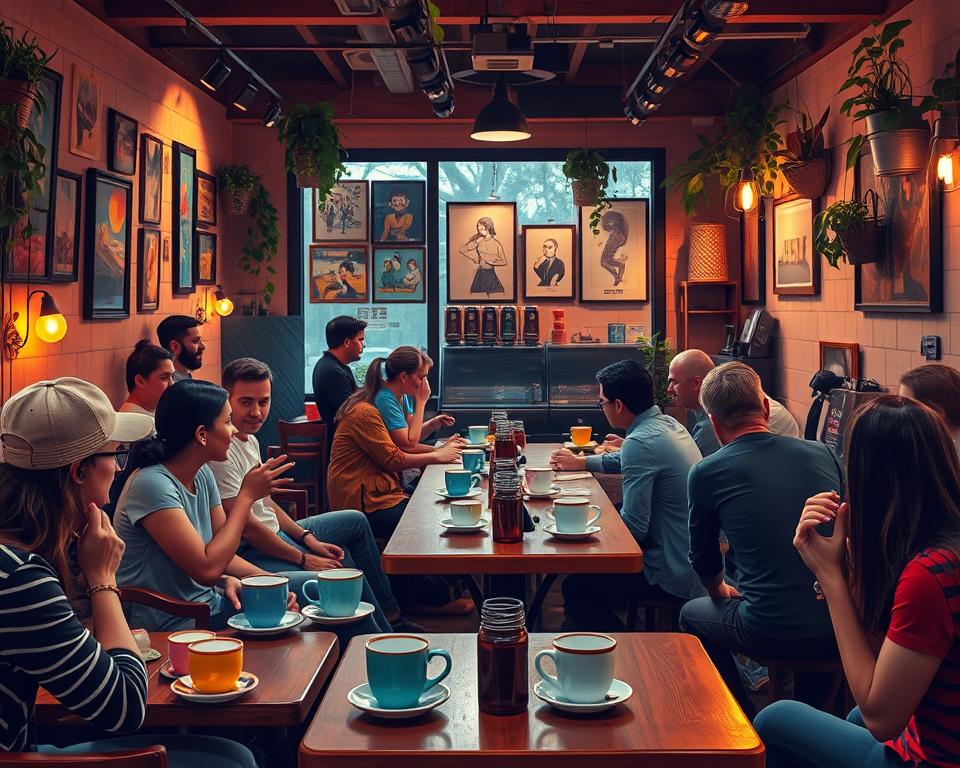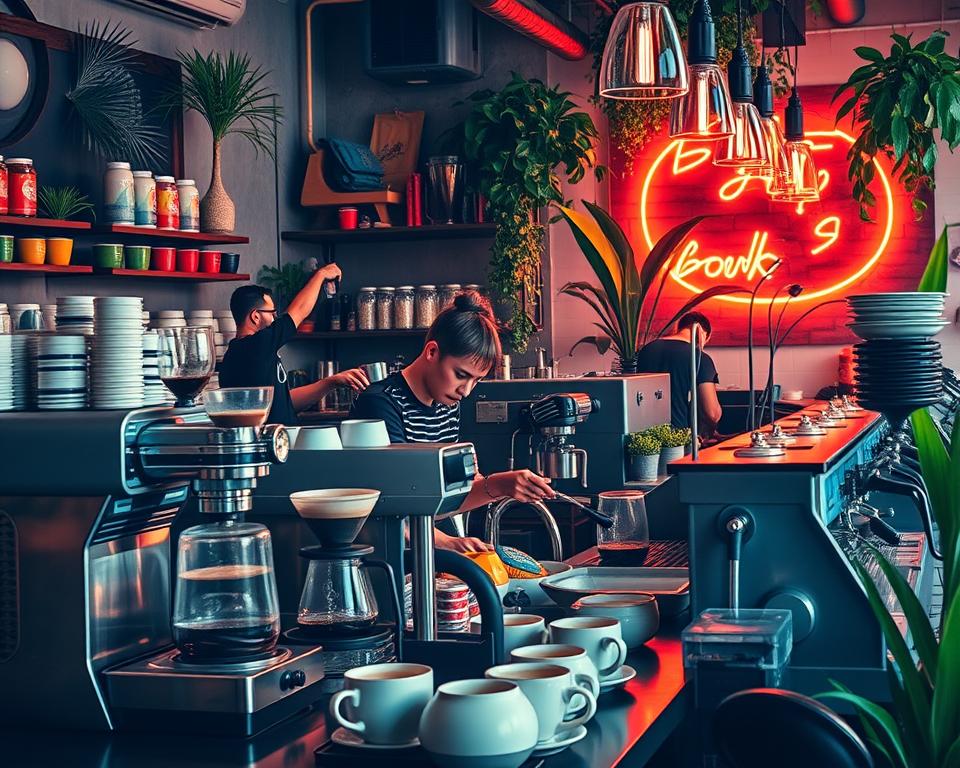The sounds of espresso machines and the scent of fresh coffee make for more than just an ordinary day. They symbolise the Second Wave of Coffee, a key time in coffee’s history. This period transformed coffee into a sign of elegance and social bonding. Brands like Starbucks and Peet’s make artisanal coffee and roasting common in our lives.
As someone who loves coffee, I’ve seen how Second Wave coffee has changed our experiences. Baristas, at the core of this movement, do more than just meet our caffeine needs. They create spaces where we can enjoy coffee’s rich flavors. It’s important to highlight how espresso and cappuccino became favorites. Yet, it was the charming cafes that made drinking coffee a special ritual.
In our busy cities, the concept of a “third place” was born. It’s a place away from home and work where I can unwind, catch up with friends, or read, surrounded by the atmosphere of coffee enthusiasts. The Second Wave didn’t just alter coffee; it transformed our culture too.
Key Takeaways
- Second Wave Coffee represented a major shift from coffee as a mere commodity to a luxurious everyday experience.
- Brands such as Starbucks and Peet’s Coffee were instrumental in popularising artisanal coffee and specialised coffee roasting.
- The rise of barista craftsmanship and the adoption of Italian coffee-brewing methods characterised this era.
- Second Wave Coffee gave rise to the concept of coffee shops as “third places” for socialising and relaxation.
- This wave laid the foundation for the diverse coffee culture we enjoy today, combining quality with a rich, inviting ambiance.
The Origins of Second-Wave Coffee
The journey from simple brews to a rich coffee culture is both historic and innovative. This story takes us through the transformative era of Second Wave Coffee.
It shows how it changed our daily coffee rituals and impacted coffee lovers globally.
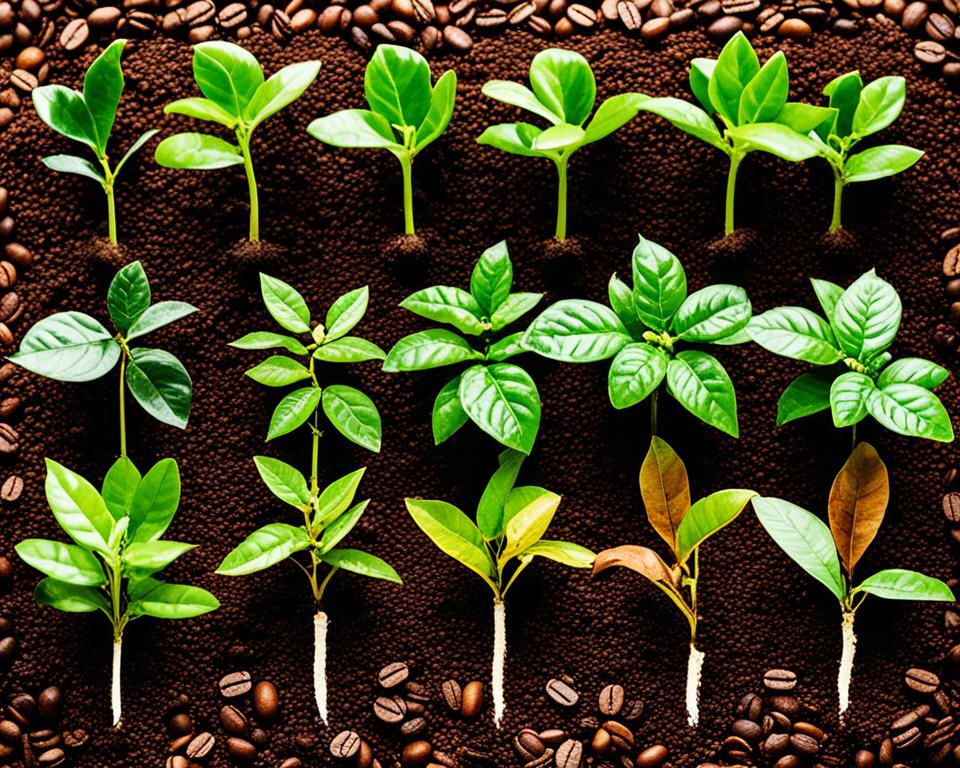
From commodity to culinary delight
Coffee beans transformed from simple goods into culinary marvels. This shift started in the 1990s, setting a new trend in coffee culture. Starbucks and Peet’s Coffee led the charge.
They focused on quality, making each cup special. Their efforts sparked a revolution, celebrating the variety and richness of coffee.
Starbucks and the Coffee Experience Revolution
Enjoying a cup of coffee became more than a simple act. Starbucks, through Howard Schultz’s vision, offered not just coffee but an experience. They popularised Italian coffee styles, turning them into household terms.
This change was about more than the coffee. It was also about creating a space for community, work, or solitude.
The Introduction of Italian Espresso Culture
Espresso, from Italy, added a bold flavour to coffee culture. It ushered in an era where “cappuccino” and “espresso” became daily languages. Coffee shifted from a commodity to an art form. Italian coffee culture enriched our conversations and enjoyment of coffee.
The table below shows Second Wave Coffee’s remarkable growth. It highlights the movement from homebrewing to a focus on science and ethics. This showcases the evolution of coffee culture over the years.
| Wave | Key Companies | Focus | Impact |
|---|---|---|---|
| First Wave | Folgers, Maxwell House | Global production, accessibility | Popularized coffee consumption at home |
| Second Wave | Starbucks, Peet’s Coffee | Quality, experience | Elevated coffee: from a drink to an experience |
| Third Wave | Artisanal Coffee Shops | Specialty coffees, ethical sourcing | Highlighted single-origin and unique flavor profiles |
| Fourth Wave | Local Stores, Online Roasters | Science, community, and commercial focus | Democratized high-quality coffee and ethical business practices |
Second Wave Coffee and Its Global Impact
The second wave coffee movement has truly changed coffee culture around the world. Companies like Starbucks have led the way, reshaping not just local cafes but also how we live globally.
From Melbourne’s famous coffee scene to Peet’s Coffee & Tea’s craft approach, a focus on quality has taken the world by storm.
Starbucks stands as a pillar of this movement, boasting over 23,000 cafes worldwide. It’s not just their size, but their push for higher coffee standards that’s influential.
For example, their $20 million premium roastery in Seattle highlights their lean into the third-wave coffee scene, aimed at those seeking an upscale experience.
Specialty coffee, marked by beans scoring 80 or above on the quality scale, invites a discerning approach to flavors and craft.
There’s been a big shift in how we consume coffee, especially at home. For instance, 30% of remote workers have single-cup brewers, showing a high value on quality.
Social media, too, plays a big role, with 49% of Gen Z learning about coffee on platforms like TikTok. This shows how second-wave coffee has built a knowledgeable, connected community.
| Coffee Trend | Remote Workers | Non-Remote Workers | Gen Z |
|---|---|---|---|
| Owns Single-Cup Brewer | 30% | 25% | N/A |
| Owns Pour-Over Set | 20% | <10% | N/A |
| Learning About Coffee on Social Media | N/A | N/A | 49% |
| Ordered a Cold Coffee Drink (First Half of 2022) | N/A | N/A | Over 60% |
The influence of second-wave coffee goes beyond just a fad. It has deeply woven into our world, impacting our daily lives.
From Starbucks on the corner to small craft cafes, this movement shapes how we enjoy our coffee everywhere.
Artisanal Coffee Brewing Techniques
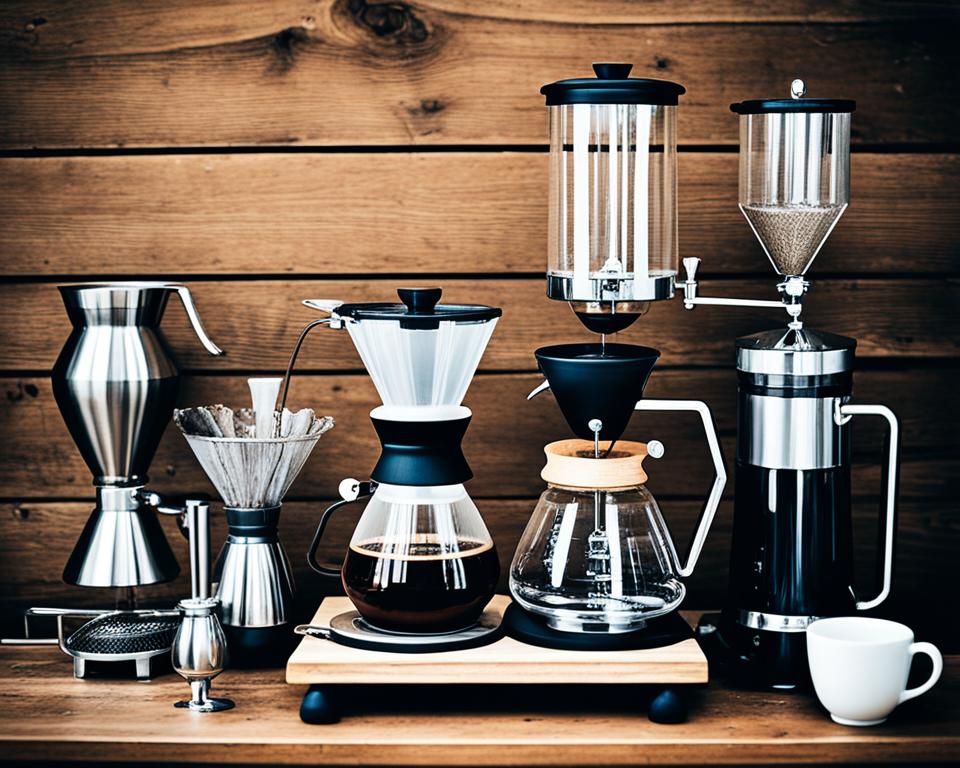
Today, artisanal coffee captivates many in the coffee world. It’s not just a passing trend; it’s a culture focused on the quality of beans and detail-oriented coffee making.
As a barista and coffee enthusiast, I’ve seen and helped the growth of brewing methods. This growth marks a coffee renaissance.
The Rise of the Barista as a Coffee Artisan
Baristas have become more than just coffeemakers; they’re now artists. Their canvas? It’s the espresso machines that shine on cafe counters. They challenge baristas to make the perfect shot.
The barista, blending with the machine, creates not just coffee but an experience. About 80% of customers love the crafts they see.
Espresso Machines and the Craft of Coffee Making
Espresso machines are key to our craft. These tools ensure that our coffee is precise and consistent. These machines started in Italian cafes but are now key in the artisanal coffee scene on Long Island.
For instance, Gentle Brew Coffee shows how traditional coffee brewing methods and advanced technology can come together.
From Beans to Brew: The Journey of Coffee Roasting
Coffee roasting is a detailed process of heating and timing. It takes a good nose and ear to unlock the flavours of green beans. The roaster’s role is just as crucial as the barista’s.
On Long Island, various roasteries highlight the art of roasting. They’ve joined a focus on roasting quality beans central to third-wave coffee culture.
| Statistic | Detail |
|---|---|
| Customer Interest | 80% intrigued by in-house coffee roasting |
| Gentle Brew Coffee Longevity | Established in 2010, in Long Beach for 2 years |
| Artisanal Movement on Long Island | Multiple establishments contributing |
| Third Wave Coffee Timeline | Origins about 15 years ago on the West Coast |
| Third Wave Focus | Quality of beans and precision in-house roasting |
Branded Coffee Chains vs. Local Coffee Houses
Exploring the world of coffee reveals a battle between branded coffee chains and local coffee houses. Starbucks sets a high standard worldwide. However, a shift is happening.
More states are choosing diverse coffee scenes in recent years. Local spots shine with their unique coffee tastes, cozy vibes, and friendly service.
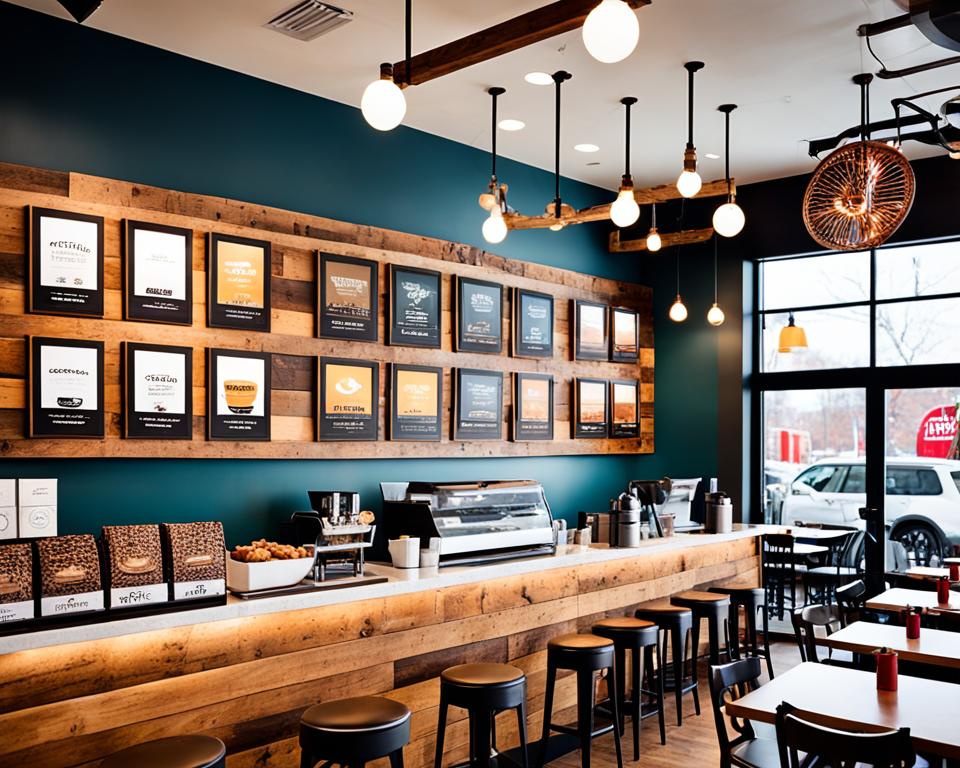
Now, more cafes roast their own beans, showing their love for craft. This approach gives us more than just coffee; it tells a story. Conversely, many cafes feature a mix of local and international coffees.
This competition creates a rich variety of coffee experiences for us. It’s a trend both small cafes and big names like Starbucks are getting into.
Each coffee shop visit shows the hard work behind each cup. The vibe is always lively and welcoming. It proves that, despite challenges, coffee places are committed to creating the perfect spot.
They honor coffee culture by blending tradition with new trends.
Embracing Coffee Culture Beyond the Cup
The third wave of coffee has changed coffee culture in many ways. Coffee shops have become key social places and show off a new kind of identity. I now see coffee shops as more than spots for caffeine.
They’re where lifestyle, taste, and friends come together to make something special for each person. This change is part of a bigger story about quality, ethics, and community coming together.
The Third Place: Coffee Shops as Social Hubs
Third-wave coffee shops offer more than just coffee. They are my “third place,” apart from work or home. It’s where I find a community and feel at ease.
These places are where friendships start over detailed coffee brewing or talk about the unique flavors of single-origin beans. Coffee shops have turned into lively social hubs, becoming a part of who I am as much as they serve great coffee.
Impact of Second Wave Coffee on Coffeehouse Aesthetics
The look and feel of coffeehouses today come from the second wave. Coffeehouse design has become an art, blending comfort with style.
I find myself in places that not only satisfy my taste but also give me a sense of belonging. These spaces, where the coffee and atmosphere are both rich, showcase the lifestyle of third-wave coffee.
Coffee as a Reflection of Lifestyle and Identity
In the colorful world of coffee culture, every espresso shot tells a story. I see coffee as a reflection of my identity. The dedication of baristas, ethical bean sourcing, and the careful preparation of each cup match my values.
Going to a coffee shop reaffirms who I am and who I want to be — a mindful enthusiast in a world where coffee quality and identity are linked.
| Italian Coffee Culture | Third Wave of Coffee |
|---|---|
| Espresso consumption at 70% | Preference for lighter roast profiles |
| 149,000 traditional coffee bars | 100 specialty coffee shops in 2018 |
| Average espresso price: €1.10 | Consumer interest in origin transparency |
| Strong preference for strong, bitter flavors | Growing fascination with by-the-cup brewing methods |
| Espresso and moka over filter coffee | Manual brewing methods like pour-over cones and French presses |
| Challenges in embracing third-wave Coffee Movement | Evolution toward enhancing flavor profiles and quality |
How Does Second Wave Coffee Compare to the Experience of Dream Coffee?
Second wave coffee focuses on the craft and quality of brewing, often highlighting rich flavors and origins. In contrast, the dream coffee experience elevates this with an immersive atmosphere, sensory engagement, and a personal touch. While both celebrate coffee culture, the latter offers a deeper, more emotional connection.
Conclusion
The journey through second-wave coffee culture has been amazing. It’s about taste, community, and creativity coming together. This era introduced specialty coffee and new brewing methods.
Iconic brands changed the game, turning coffee beans into an art form. Now, roasting coffee is celebrated in cafes and homes.
The spirit of innovation continues to drive the coffee culture forward. As an aficionado, I’ve seen coffee become a craft item in boutique cafes. This movement cares about quality and where coffee comes from. It promises a better future for the coffee world and its fans.
The impact of second-wave coffee is strong and lasting. It excites me, like the diligent work of sommeliers. I can’t wait for the next delicious cup that tells the story of its origin and the skill in its creation.
FAQ
What defines second-wave coffee?
Second Wave Coffee turns coffee into an art. It began with Starbucks and Peet’s Coffee, who focused on high-quality beans and brewing. They made enjoying coffee a special experience, with espresso drinks becoming popular. This made coffee more about quality and social moments.
How did Starbucks revolutionise the coffee experience?
Starbucks changed the coffee culture by embracing Italian espresso and creating cosy cafes. These cafes became a “third place” away from work or home. This approach, focusing on great coffee and a welcoming space, influenced coffee culture worldwide.
What is the significance of Italian espresso culture in second-wave coffee?
Italian espresso culture is key to Second Wave Coffee. It brought the art of espresso to more people. This culture showed the craft of making espresso, setting high standards for coffee shops everywhere.
How has Second Wave Coffee impacted the global coffee scene?
Second Wave Coffee introduced specialty coffee and skillful brewing worldwide. Starbucks played a big role, opening shops even in places with strong coffee traditions. This movement helped people everywhere enjoy better coffee.
What are the main coffee brewing techniques associated with Second Wave Coffee?
Second Wave Coffee uses techniques that highlight the bean’s flavor. This includes espresso machines for strong coffee shots, steaming milk for drinks like cappuccinos, and careful bean roasting to enhance taste.
What is the difference between branded coffee chains and local coffee houses?
Branded chains like Starbucks guarantee the same quality and feel everywhere. They focus on espresso drinks and cosy atmospheres. Local coffee houses offer unique vibes, support their community, and often use local beans for a more personal touch.
How do coffee shops serve as social hubs in today’s culture?
Coffee shops are key places for people to meet, work, and hang out. They act as a “third place” for socialising in a relaxed environment. This has made them central to modern social life and community.
Why is coffee often seen as a reflection of lifestyle and identity?
Coffee is more than a drink; it reflects personal choices and identity. The types of coffee and cafes people choose can say a lot about their values and style. This makes coffee a personal statement.

